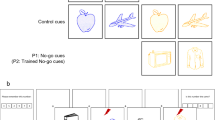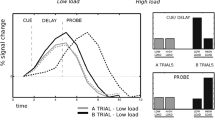Abstract
How the brain prepares for forthcoming events is a pivotal question in human neuroscience. In the last years, several studies have suggested that expectations of perceiving upcoming stimuli engage relevant perceptual areas. Similarly, some experiments manipulating the task to be performed with targets have also found pre-activations in task-related brain areas. However, the usual configuration of this type of paradigms entails high levels of interference and/or working memory load, together with a small set of target stimuli. We designed a cued task paradigm in which interference was reduced to a minimum, as evidenced by behavioral indices of performance, and that included a high number of targets to avoid their anticipation. This was achieved using a large set of univalent target stimuli preceded by fully valid cues in a functional magnetic resonance imaging experiment. We found category-specific patterns of activity in which semantic cues engaged the left inferior frontal gyrus whereas spatial cues preactivated the right superior parietal lobe. Together with functional connectivity analyses, the activation maps showed the specific involvement of semantic and spatial processes upon the presentation of the cues that are coherent with previous literature. Our results thus suggest that even in contexts of low interference that prevent the anticipation of specific targets, our brain takes advantage of current information to deal with upcoming demands.




Similar content being viewed by others
References
Ardila A, Bernal B, Rosselli M (2014) Participation of the insula in language revisited: a meta-analytic connectivity study. J Neurolinguist 29:31–41
Baddeley A (2003) Working memory: looking back and looking forward. Nat Rev Neurosci 4:829–839
Baldauf D, Desimone R (2014) Neural mechanisms of object-based attention. Science 344:424–427
Binder JR, Frost JA, Hammeke TA, Cox RW, Rao SM, Prieto T (1997) Human brain language areas identified by functional magnetic resonance imaging. J Neurosci 17:353–362
Bode S, Haynes JD (2009) Decoding sequential stages of task preparation in the human brain. Neuroimage 45:606–613
Brass M, von Cramon DY (2002) The role of the frontal cortex in task preparation. Cereb Cortex 12:908–914
Brass M, von Cramon DY (2004) Selection for cognitive control: a functional magnetic resonance imaging study on the selection of task-relevant information. J Neurosci 24:8847–8852
Chang LJ, Yarkoni T, Khaw MW, Sanfey AG (2012) Decoding the role of the insula in human cognition: functional parcellation and large-scale reverse inference. Cereb Cortex 23:739–749
Chawla D, Rees G, Friston KJ (1999) The physiological basis of attentional modulation in extrastriate visual areas. Nat Neurosci 2:671–676
Constantinidis C (2006) Posterior parietal mechanisms of visual attention. Rev Neuroscience 17:415–428
Corbetta M, Miezin FM, Dobmeyer S, Shulman GL, Petersen SE (1990) Attentional modulation of neural processing of shape, color, and velocity in humans. Science 248:1556–1559
Corbetta M, Patel G, Shulman GL (2008) The reorienting system of the human brain: from environment to theory of mind. Neuron 58:306–324
Curtis CE, D’Esposito M (2003) Persistent activity in the prefrontal cortex during working memory. Trends Cogn Sci 7:415–423
De Baene W, Brass B (2013) Switch probability context (in)sensitivity within the cognitive control network. Neuroimage 77:207–215
De Baene W, Brass B (2014) Dissociating strategy-dependent and independent components in task preparation. Neuropsychologia 62:331–340
Donohue S, Wendelken C, Bunge S (2008) Neural correlates of preparation for action selection as a function of specific task demands. J Cognitive Neurosci 20:694–706
Dosenbach NU, Fair DA, Cohen AL, Schlaggar BL, Petersen SE (2008) A dual-networks architecture of top-down control. Trends Cogn Sci 12:99–105
Duncan J (2010) The multiple-demand (MD) system of the primate brain: mental programs for intelligent behaviour. Trends Cogn Sci 14:172–179
Elchlepp H, Lavric A, Mizon GA, Monsell S (2012) A brain-potential study of preparation for and execution of a task-switch with stimuli that afford only the relevant task. Hum Brain Mapp 33:1137–1154
Esterman M, Yantis S (2009) Perceptual expectation evokes category-selective cortical activity. Cereb Cortex 20:1245–1253
Fiez JA (1997) Phonology, semantics, and the role of the left inferior prefrontal cortex. Hum Brain Mapp 5:79–83
Friston K (2003) Learning and inference in the brain. Neural Netw 16:1325–1352
Friston K (2005) A theory of cortical responses. Philos T Roy Soc B 360(1456):815–836
Friston KJ, Buechel C, Fink GR, Morris J, Rolls E, Dolan RJ (1997) Psychophysiological and modulatory interactions in neuroimaging. Neuroimage 6:218–229
Gilbert CD, Sigman M (2007) Brain states: top-down influences in sensory processing. Neuron 54:677–696
Goodale MA, Milner AD (1992) Separate visual pathways for perception and action. Trends Neurosci 15:20–25
Harris IM, Benito CT, Ruzzoli M, Miniussi C (2008) Effects of right parietal transcranial magnetic stimulation on object identification and orientation judgments. J Cognitive Neurosci 20:916–926
Husain M, Nachev P (2007) Space and the parietal cortex. Trends Cogn Sci 11:30–36
Jefferies E (2013) The neural basis of semantic cognition: converging evidence from neuropsychology, neuroimaging and TMS. Cortex 49:611–625
Kastner S, Pinsk MA (2004) Visual attention as a multilevel selection process. Cogn Affect Behav Neurosci 4:483–500
Kiesel A, Steinhauser M, Wendt M, Falkenstein M, Jost K, Philipp AM, Koch I (2010) Control and interference in task switching—A review. Psychol Bull 136:849
Klauer KC, Zhao Z (2004) Double dissociations in visual and spatial short-term memory. J Exp Psychol Gen 133:355
Logan GD, Bundesen C (2004) Very clever homunculus: compound stimulus strategies for the explicit task-cuing procedure. Psychon B Rev 11:832–840
Manelis A, Reder LM (2013) He Who is well prepared has half won the battle: an fMRI Study of task preparation. Cereb Cortex 25:726–735
McCandliss BD, Cohen L, Dehaene S (2003) The visual word form area: expertise for reading in the fusiform gyrus. Trends Cogn Sci 7:293–299
Meiran N (2000) Modeling cognitive control in task-switching. Psychol Res 63(3-4):234–249
Nichols T, Brett M, Andersson J, Wager T, Poline JB (2005) Valid conjunction inference with the minimum statistic. Neuroimage 25:653–660
Noonan KA, Jefferies E, Visser M, Ralph MAL (2013) Going beyond inferior prefrontal involvement in semantic control: evidence for the additional contribution of dorsal angular gyrus and posterior middle temporal cortex. J Cognitive Neurosci 25:1824–1850
Price CJ (2000) The anatomy of language: contributions from functional neuroimaging. J Anat 197:335–359
Puri AM, Wojciulik E, Ranganath C (2009) Category expectation modulates baseline and stimulus-evoked activity in human inferotemporal cortex. Brain Res 1301:89–99
Ruge H, Jamadar S, Zimmermann U, Karayanidis F (2013) The many faces of preparatory control in task switching: reviewing a decade of fMRI research. Hum Brain Mapp 34:12–35
Ruz M, Nobre A (2008a) Attention modulates initial stages of visual word processing. J Cognitive Neurosci 20:1727–1736
Ruz M, Nobre A (2008b) Dissociable top-down anticipatory neural states for different linguistic dimensions. Neuropsychologia 46:1151–1160
Ruz M, Wolmetz ME, Tudela P, McCandliss BD (2005) Two brain pathways for attended and ignored words. Neuroimage 27:852–861
Sakai K (2008) Task set and prefrontal cortex. Annu Rev Neurosci 31:219–245
Sakai K, Passingham RE (2003) Prefrontal interactions reflect future task operations. Nat Neurosci 6:75–81
Sakai K, Passingham RE (2006) Prefrontal set activity predicts rule-specific neural processing during subsequent cognitive performance. J Neurosci 26:1211–1218
Shi Y, Meindl T, Szameitat AJ, Müller HJ, Schubert T (2014) Task preparation and neural activation in stimulus-specific brain regions: an fMRI study with the cued task-switching paradigm. Brain Cognition 87:39–51
Stokes MG, Kusunoki M, Sigala N, Nili H, Gaffan D, Duncan J (2013) Dynamic coding for cognitive control in prefrontal cortex. Neuron 78:364–375
Summerfield C, Egner T (2009) Expectation (and attention) in visual cognition. Trends Cogn Sci 13(9):403–409
Summerfield C, Egner T, Greene M, Koechlin E, Mangels J, Hirsch J (2006) Predictive codes for forthcoming perception in the frontal cortex. Science 314:1311–1314
Van Essen DC (2005) A population-average, landmark-and surface-based (PALS) atlas of human cerebral cortex. Neuroimage 28:635–662
Wagner AD, Paré-Blagoev EJ, Clark J, Poldrack RA (2001) Recovering meaning: left prefrontal cortex guides controlled semantic retrieval. Neuron 31:329–338
Wendt M, Luna-Rodriguez A, Reisenauer R, Jacobsen T, Dreisbach G (2012) Sequential modulation of cue use in the task switching paradigm. Front Psychology 3:287
Wylie GR, Javitt DC, Foxe JJ (2006) Jumping the gun: is effective preparation contingent upon anticipatory activation in task-relevant neural circuitry? Cereb Cortex 16:394–404
Yamagata T, Nakayama Y, Tanji J, Hoshi E (2012) Distinct information representation and processing for goal-directed behavior in the dorsolateral and ventrolateral prefrontal cortex and the dorsal premotor cortex. J Neurosci 32:12934–12949
Yeung N, Nystrom LE, Aronson JA, Cohen JD (2006) Between-task competition and cognitive control in task switching. J Neurosci 26:1429–1438
Acknowledgments
Financial support to this research came from the Spanish Ministry of Science and Innovation through a ‘Ramón y Cajal’ research fellowship (RYC-2008-03008) and grant PSI2013-45567-P to M.R, and PSI2011-23624 to R.de D.B. This research is part of C.G-G’s activities for the Psychology Graduate Program of the University of Granada.
Author information
Authors and Affiliations
Corresponding author
Ethics declarations
Conflict of interest
The authors declare that they have no conflict of interest.
Ethical approval
All procedures performed in studies involving human participants were in accordance with the ethical standards of the institutional and/or national research committee and with the 1964 Helsinki declaration and its later amendments or comparable ethical standards.
Informed consent
Informed consent was obtained from all individual participants included in the study.
Rights and permissions
About this article
Cite this article
González-García, C., Mas-Herrero, E., de Diego-Balaguer, R. et al. Task-specific preparatory neural activations in low-interference contexts. Brain Struct Funct 221, 3997–4006 (2016). https://doi.org/10.1007/s00429-015-1141-5
Received:
Accepted:
Published:
Issue Date:
DOI: https://doi.org/10.1007/s00429-015-1141-5




